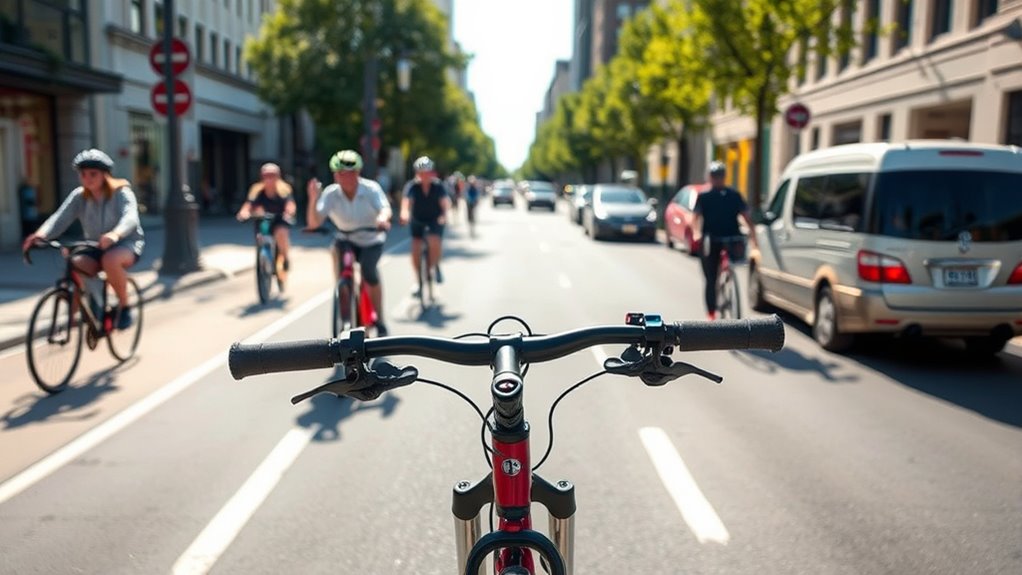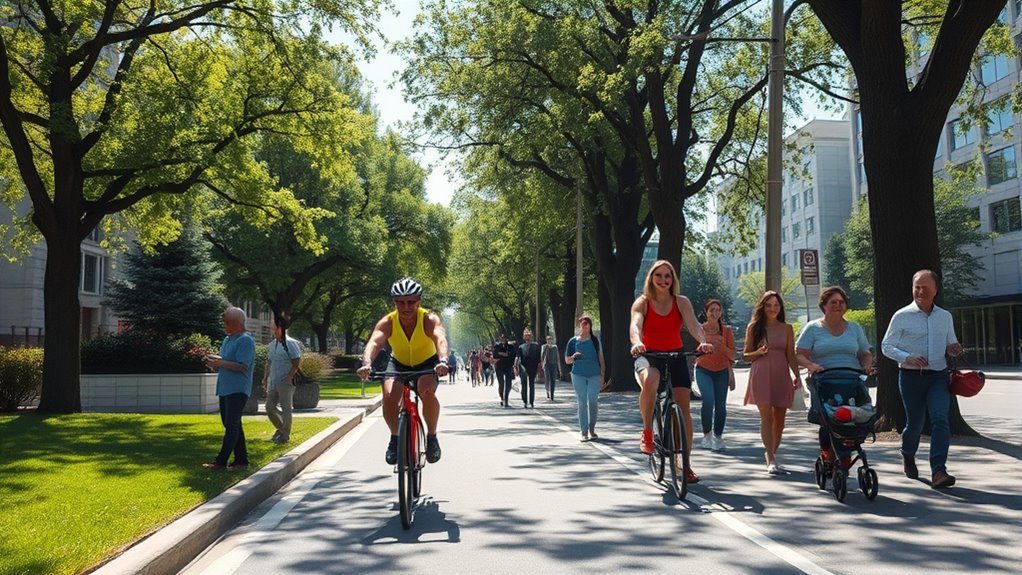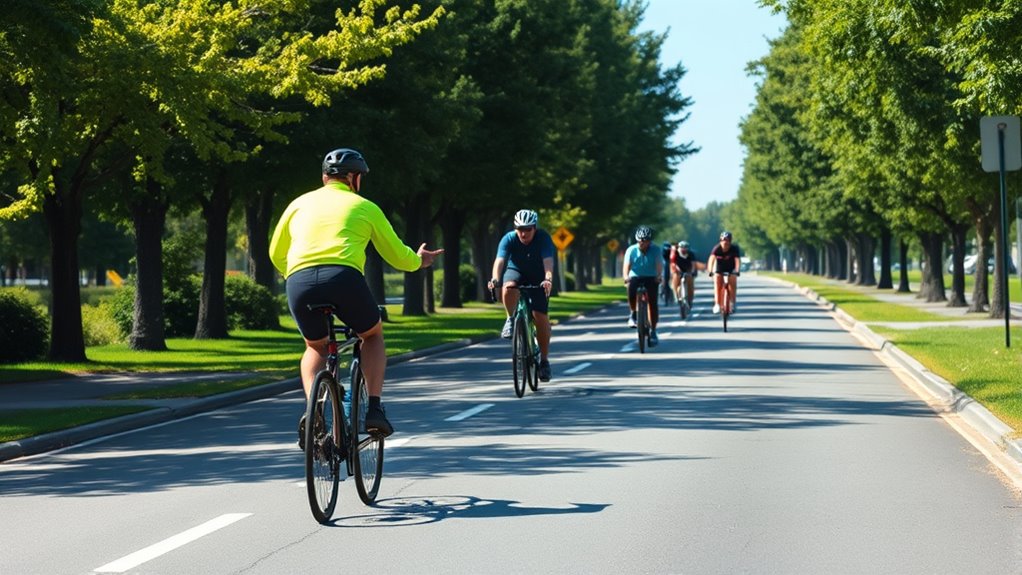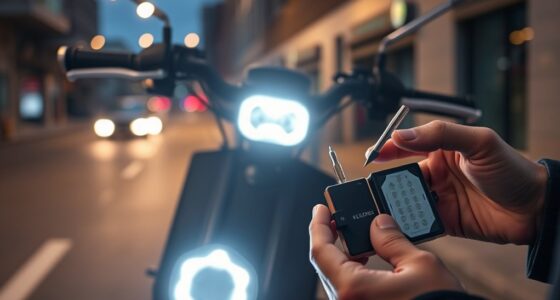When riding shared paths and bike lanes, respect speed limits and signage to stay safe. Maintain a predictable line, avoid weaving, and scan ahead for hazards. Use clear hand signals to communicate turns or stops, and give way to pedestrians and other riders. Be considerate by slowing near crossings and keeping your space tidy. Following these guidelines helps everyone stay safe, creates harmony, and makes your riding experience better—continue to learn more about proper etiquette.
Key Takeaways
- Follow posted speed limits and signage to ensure safety and predictability for all path users.
- Maintain a consistent lane position and stay centered to help others anticipate your movements.
- Use clear hand signals and visual cues to communicate turns, stops, and lane changes.
- Yield appropriately to pedestrians and give way at intersections or crowded areas.
- Be considerate by slowing down near pedestrians, keeping the path clean, and avoiding hazards.
Respect Speed Limits and Signage

To guarantee everyone’s safety on shared paths and bike lanes, it’s essential that you respect posted speed limits and signage. Signage compliance ensures that you adhere to designated speed regulation, reducing the risk of accidents. When you follow these signs, you help maintain a safe environment for pedestrians, cyclists, and yourself. Ignoring speed limits or signage can lead to dangerous situations and potential injuries. Always stay within the recommended speed to allow for quick reactions and smooth traffic flow. By paying attention to signage, you demonstrate respect for shared space rules and contribute to a safer cycling experience for everyone. Remember, responsible riding isn’t just about your safety—it’s about protecting the entire community using shared paths and bike lanes. Practicing mindfulness and presence while cycling can also help you stay alert and responsive to your surroundings.
Maintain a Safe and Predictable Line of Travel

Maintaining a safe and predictable line of travel helps prevent accidents and keeps everyone on shared paths and bike lanes safe. You should focus on proper lane positioning to stay in a consistent, visible spot, making your movement predictable to others. Avoid weaving between pedestrians or vehicles, which can cause confusion. Keep obstacle awareness front and center; scan your path ahead for potential hazards like potholes, debris, or pedestrians, and adjust your lane position accordingly. Staying centered in your lane and maintaining steady speed helps others anticipate your movements. Being mindful of your lane placement and aware of obstacles can also help you maximize space and organization, reducing the risk of collisions and helping to create a smooth flow of traffic for everyone sharing the space.
Use Hand Signals and Communicate Clearly

Communicating your intentions clearly is essential for safe sharing of paths and bike lanes. Using hand signals and visual cues helps others anticipate your movements and reduces accidents. Always make your signals obvious and timely. For example, extend your arm to indicate a turn, or use a quick wave to acknowledge pedestrians or other cyclists. Here are key tips:
- Use clear hand signals to show when you’re turning or stopping.
- Maintain eye contact or use a friendly wave to confirm your presence.
- Keep your gestures simple and visible, especially at intersections or when changing lanes.
- Being aware of ex-relationships can help you stay attentive and considerate of others sharing the space.
Yield and Give Way Appropriately

Understanding when to yield or give way is essential for safe sharing of paths and bike lanes. Good passing etiquette and overtaking safety depend on knowing who has the right of way. Always slow down and be prepared to stop when approaching intersections, pedestrians, or other cyclists. If someone is overtaking you, give them enough space and avoid sudden moves. Use clear hand signals to communicate your intentions. Remember, yielding isn’t a sign of weakness; it keeps everyone safe and smooths traffic flow. Incorporating AI security measures can help monitor shared path usage and enhance safety protocols.
Be Mindful of Pedestrians and Others

Are you aware of how your actions can impact pedestrians and other path users? Shared space awareness is essential to guarantee everyone’s safety. When riding, always slow down near pedestrian crossings or crowded areas, giving priority to pedestrians. Be attentive during pedestrian interaction—make eye contact if needed, and signal clearly before passing. Remember, shared paths are for all; respecting others fosters a safer environment. Keep these points in mind:
- Stay alert and reduce your speed in busy zones
- Yield to pedestrians crossing or waiting to cross
- Use a friendly, respectful tone when interacting
- Incorporate vintage decor elements to complement the rustic environment and promote a calming atmosphere for all users.
Keep Your Space Clean and Be Considerate

Keeping your shared paths clean isn’t just about appearances—it helps everyone stay safe and comfortable. Proper trash management prevents debris that could cause accidents, and bike lane sanitation keeps the surface safe for all riders. Always dispose of your trash properly and avoid leaving any litter behind. Be considerate of others by not blocking the path with your belongings or waste. To emphasize this, consider the importance of trash management:
| Action | Benefit | Responsibility |
|---|---|---|
| Properly dispose of trash | Prevents accidents and litter | Every rider |
| Report hazards | Maintains bike lane sanitation | Community members |
| Clean up spills | Ensures safe riding surface | All riders |
| Avoid leaving debris | Keeps shared paths safe | Everyone |
Maintaining a clean environment also involves understanding the importance of color accuracy in visibility and safety during rides.
Frequently Asked Questions
How Should I Handle Conflicts With Aggressive or Inconsiderate Cyclists?
When handling confrontation with aggressive or inconsiderate cyclists, stay calm and avoid escalating the situation. Use de-escalation techniques like speaking calmly, making eye contact, and giving space to defuse tension. If the conflict persists, prioritize your safety by calmly removing yourself from the scene. Remember, addressing issues peacefully helps maintain a safe environment for everyone, and sometimes, ignoring provocative behavior is the best way to prevent further conflict.
What Is the Proper Way to Pass a Cyclist Ahead of Me?
Ah, the delicate art of passing a cyclist—like tiptoeing past a sleeping bear, but with less grumbling. You should give at least three feet of passing distance, ensuring you stay clear of their path. Signal your intentions early—use a quick hand gesture or bell—and wait for a safe moment. Patience and clear communication keep everyone safe and the trail friendly. Easy, right?
Are There Specific Rules for Riding in Groups on Shared Paths?
When riding in groups on shared paths, you should follow proper formation etiquette to keep everyone safe. Stay in a single file or a tight, organized formation to avoid obstructing others. Communicate clearly with hand signals or voice to alert your group of turns or hazards. Be considerate of other path users by maintaining steady speeds and allowing space for pedestrians. Following these group riding rules guarantees a smooth and respectful experience for everyone.
How Do I Navigate When Encountering Maintenance or Construction on Bike Lanes?
When you hit a construction zone or maintenance on bike lanes, it’s a case of a bump in the road. Signal clearly during detours to keep others in the loop, and slow down to navigate safely. If you spot hazards, report them immediately to the authorities. Staying alert and communicative helps everyone stay safe, even when the path isn’t as smooth as usual. It’s all about riding responsibly through the chaos.
What Should I Do if a Pedestrian Steps Into the Bike Lane Unexpectedly?
If a pedestrian unexpectedly steps into the bike lane, stay alert and prioritize safety. You should slow down immediately to give yourself enough time to react to sudden crossings. Make sure to maintain pedestrian awareness at all times, especially in busy areas. Gently signal your intentions if needed, and wait until the pedestrian clears the lane before continuing. Your focus on safe riding helps prevent accidents and keeps everyone safe.
Conclusion
By following these riding etiquette tips, you help create a safer, more enjoyable environment for everyone. Remember, nearly 60% of cycling accidents involve rider error or lack of communication, highlighting the importance of clear signals and respectful behavior. When you respect speed limits, yield properly, and stay mindful of pedestrians, you contribute to a smoother shared space. Keep your space clean and be considerate—your actions make a difference in making shared paths safer for all riders and pedestrians alike.









